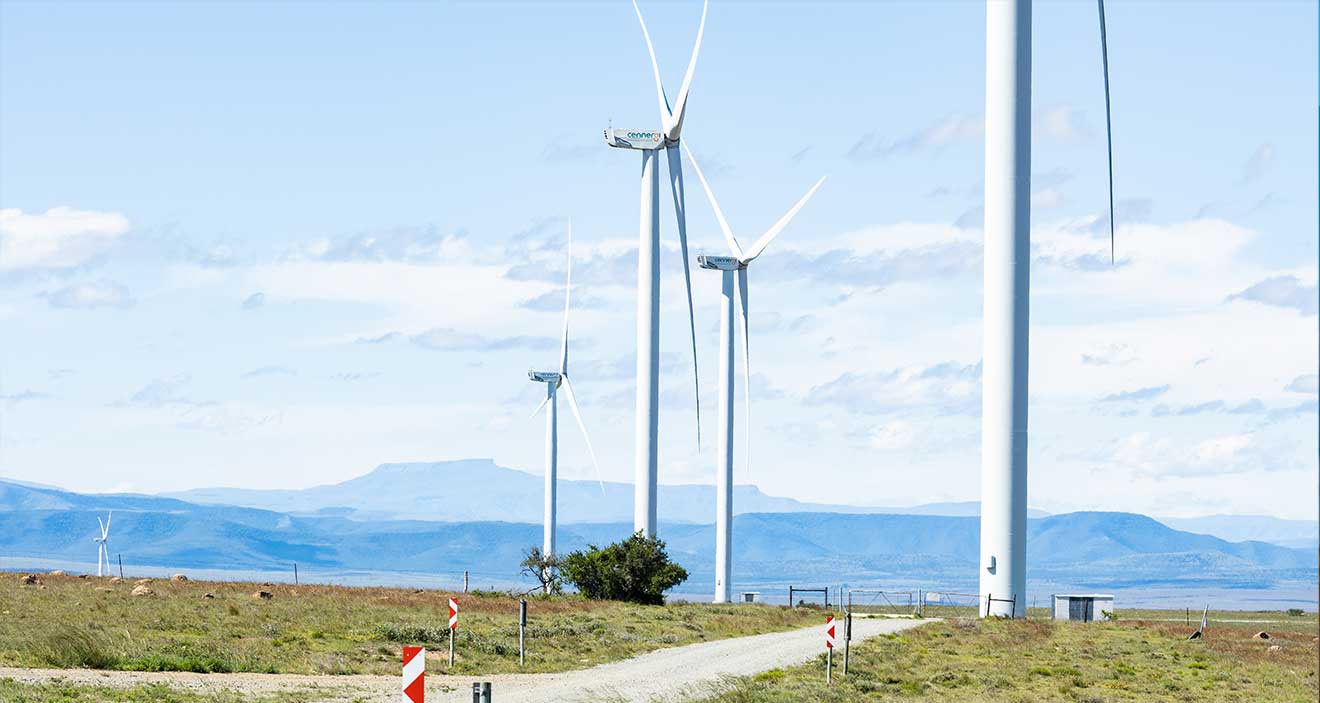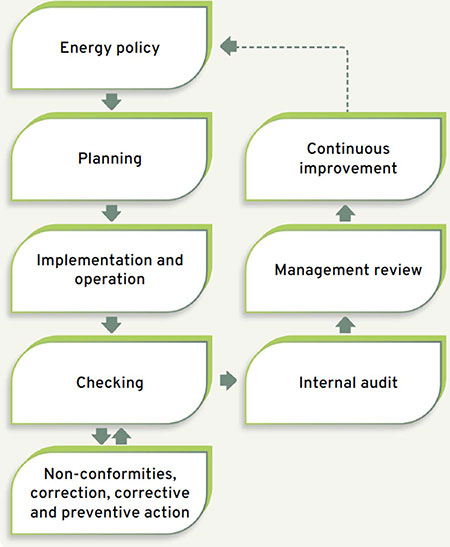Currently viewing: Energy efficiency | Next: Water security
Energy efficiency is a critical component of our decarbonisation journey. Managing our consumption and pursuing alternative energy sources in a just and sustainable manner will ensure our long-term resilience, enabling further progress towards transitioning into a low‑carbon business.
Improvement in energy intensity against the consolidated group GJ target
Fuel cleaning system launched at Mafube
To reduce our direct emissions and energy consumption in an innovative, sustainable, inclusive and proactive manner
Our energy and carbon management programme aligns with the objectives of our Climate Change Response (responsible resource consumption and CO2 emissions reports) and Sustainable Growth and Impact strategies.
![]() Make our minerals
and
energy businesses thrive
Make our minerals
and
energy businesses thrive
![]() Become a catalyst
for economic
growth and environmental stewardship
Become a catalyst
for economic
growth and environmental stewardship
![]() Be carbon
neutral by 2050
Be carbon
neutral by 2050
As part of delivering social impact through the ESD programme, Exxaro provided financial support to a fruit farmer, enabling commercial-scale expansion of the operation. We also provided a solar PV UPS system to mitigate the impact of energy supply interruptions on their produce and reduce their reliance on grid-supplied electricity.

Employees
To create awareness and drive behaviour change
Industry Task Team on Climate Change (as a member of the Energy Intensive Users Group of Southern Africa)
To share knowledge, gain insights and contribute to South Africa’s just energy transition and climate change policy
Our primary focus in 2024 will be improving plant throughput performance and electrical energy efficiency at all BUs.
Our energy efficiency efforts are critical for us to achieve our goal of being carbon neutral by 2050. Exxaro’s energy and carbon management programme outlines how we reduce our direct emissions and energy consumption. The programme is supported by:
The programme complies with ISO 50001 energy management requirements.
Energy and carbon management programme

We reduce our diesel consumption through various projects, implemented by our technology and engineering department, which use fuel additives and payload management. Our operational energy efficiency projects and renewable energy self-generation reduce electrical energy consumption. We work with our innovation department to advance our efforts in reducing electrical energy intensity.
For information on our approach to emissions, refer to the climate change adaptation and resilience section
Each operation has energy intensity targets linked to the group STI scheme. Targets are based on the outcomes of current state and opportunity scoping reviews, which began at Grootegeluk in 2021. The outcomes of the reviews also informed interventions to reduce energy consumption and GHG emissions to improve intensity (GJ per total tonnes handled).
Intensity performance is tracked monthly relative to the calculated energy intensity baseline. This baseline was calculated using the energy consumption and production data from the most recent preceding year that represented each mine’s steady-state operation.
Our energy management projects support the objectives of our Social Impact strategy.
We recognise that energy management is a collective effort, and therefore embed decarbonisation thinking across BUs and our value chain by nurturing a culture of emissions reduction and accountability through awareness, education and training.
Our people and performance, business improvement and information management teams drive behaviour change among employees, who in turn support efforts to establish energy management systems. Engineering teams champion energy-saving initiatives and motivate behaviour transformation. We discuss performance in monthly forums at each BU.
Enabling effective monitoring and verification through technology
We use independent measurement and verification services provided by ECS. ECS conducts strategic performance reviews at Grootegeluk, Matla, Belfast, Leeuwpan and FerroAlloys to assess project status, and implementation of PEMS and SmartEPS. These sessions also address shorter interval control measures to ensure each site achieves monthly STI targets.
BU managers are responsible for achieving energy management objectives, supported by the group engineering manager and chief technology officer.
| Electricity and diesel consumption | 2023 | Year-on-year change (%) |
2022 | Year-on-year change (%) |
2021 |
| Electricity (MWh) | 590 931 | 0.14 | 590 078 | 1.38 | 582 066 |
|---|---|---|---|---|---|
| RoM (kt) | 190 311 | 8.64 | 175 176 | -2.38 | 179 451 |
| Electrical energy intensity (MWh/kt) | 3.11 | -7.72 | 3.37 | 4.01 | 3.24 |
| Diesel (kl) | 83 629 | 0.48 | 83 226 | -9.38 | 91 838 |
| RoM (kt) | 190 311 | 8.64 | 175 176 | -2.38 | 179 451 |
| Diesel energy intensity (MWh/kt) | 4.39 | -10.04 | 4.88 | -7.05 | 5.25 |
Refer to the databook for more detail on our electricity, diesel, RoM and intensities.
Our primary energy sources included 41% electricity (2022: 40.7%) and 59% diesel (2022: 59%). Total energy consumed increased by 0.15% to 5 219 390GJ (2022: 5 211 418GJ).
Total electricity and diesel intensity decreased in 2023 by 9% based on the increase in RoM tonnages and improvement in energy and productivity performance in the mining areas across BUs.
Based on the 8.64% increase in RoM tonnages, electrical energy intensity decreased by 7.72% and diesel energy intensity decreased by 10.04%.
According to our group STI scheme rules, Belfast, Leeuwpan, Matla and FerroAlloys met energy intensity targets, while Grootegeluk and the group did not. The group did not achieve its 2023 energy intensity STI target based on the 2023 GIS rules. However, comparing the group total consolidated energy intensity performance for 2022 with that of 2023 (in GJ/kilotonne) shows that there was an improvement in energy intensity performance year on year. The energy intensity performance for 2022 in GJ/ kilotonne was 29.59 with the 2023 performance at 27.43, which represents a reasonable improvement in energy intensity performance year on year.
We experienced challenges in data acquisition (validity, frequency and resolution) in the second quarter of 2023, which impacted our ability to analyse, respond and correct declining energy performance at Grootegeluk.
We are improving our data collection process to enable real-time behaviour management. We developed an analytical tool to link plant production throughput with electrical energy per plant module at Grootegeluk, enabling us to monitor and manage energy intensity performance through the plant. We also implemented advanced process control in the plant modules to further improve energy efficiency.
Based on the positive results from FuelActive units installed on three haul trucks at Mafube, a similar pilot was launched on five haul trucks at Grootegeluk. The intent is to gauge the improvement in fuel consumption (expected between 3% and 5%) on the haul trucks and reduce maintenance costs.
Grootegeluk will be replacing its heavy mobile haul truck fleet, with carbon emissions and sustainability prioritised in selecting the appropriate best-fit technology partner. We are engaging with our original equipment manufacturers on this process, ensuring roadmaps will incorporate decarbonisation, sustainability and transitioning from traditional diesel‑fuelled haul trucks.
Case study:
Decarbonising our mobile equipment fleet
FuelActive is an innovative fuel cleaning system that reduces harmful emissions, fuel consumption, repair and maintenance downtime, and related costs – supporting our goal of systematically decarbonising our fleet.
FuelActive uses a floating pickup to draw clean fuel from the top of the fuel tank, instead of the bottom where contaminants settle. The system improves engine efficiency and reduces fuel consumption while maintaining the manufacturer’s intended emission standards and performance throughout equipment life. A three-month trial of this technology at Mafube compared the performance of our mining truck fleet against the manufacturer’s baseline data (collected over at least six months) – with and without the FuelActive system. We collected and managed data on fuel economy and carbon dioxide emissions every month and presented it to management and FuelActive (as average litres of diesel consumption per hour) at biweekly reviews.
Payback from our
investment within
263 days
Carbon dioxide
reduction of
762 tonnes
Annual
fuel savings of
R6 million
 Report Index
Report Index